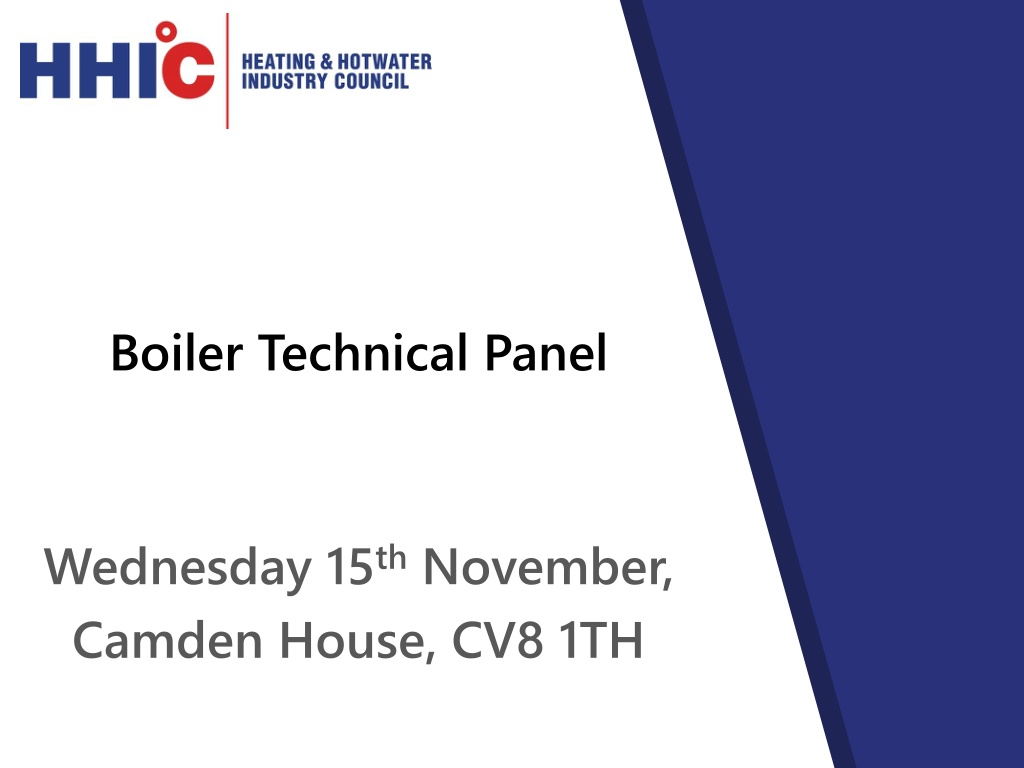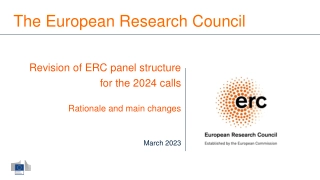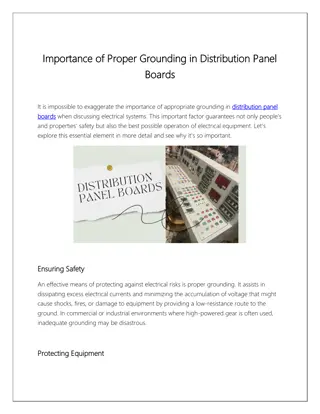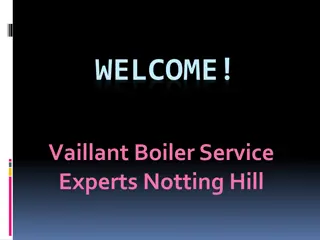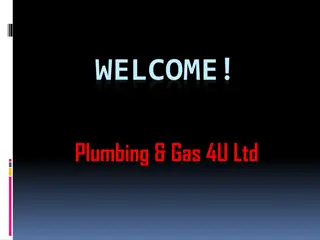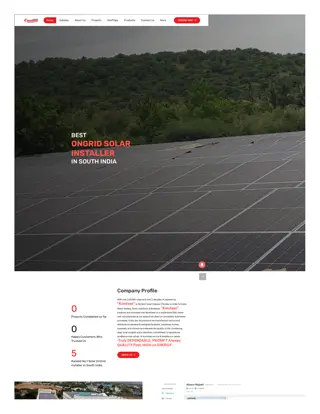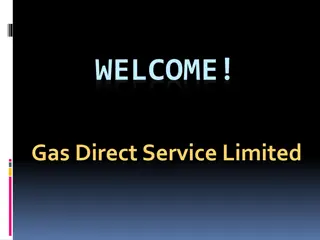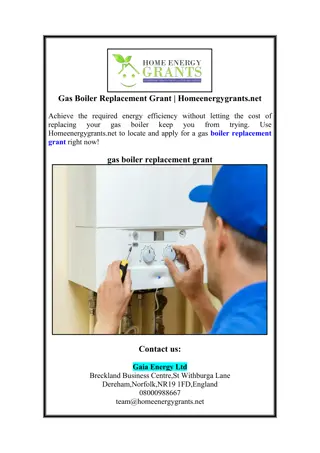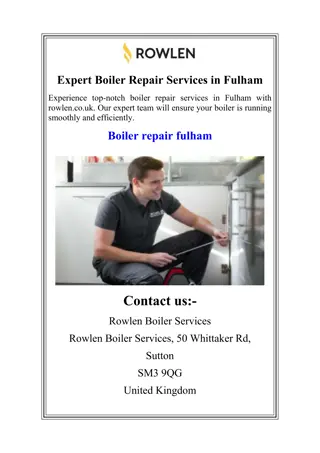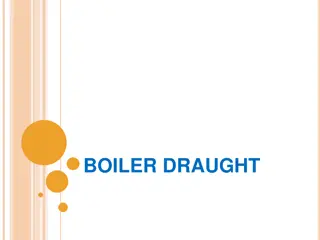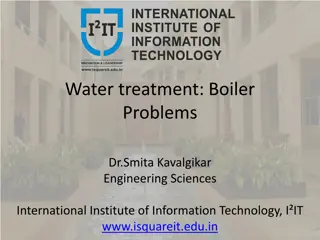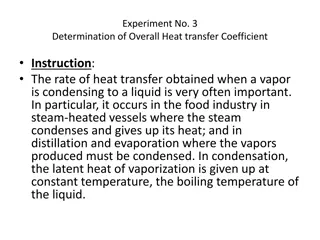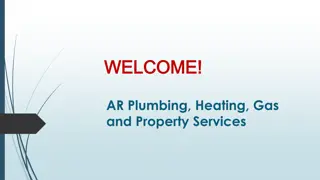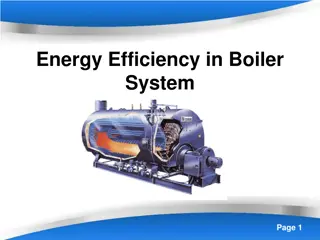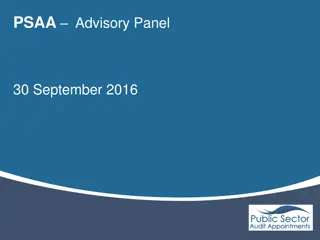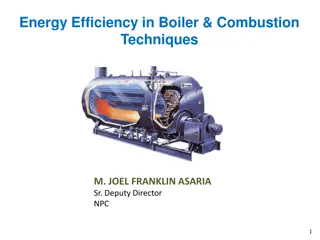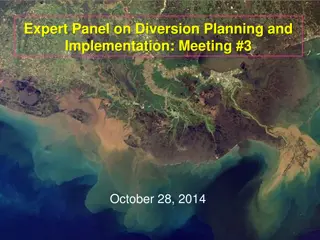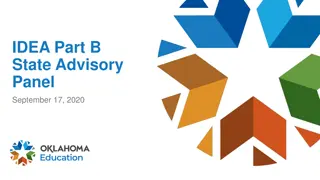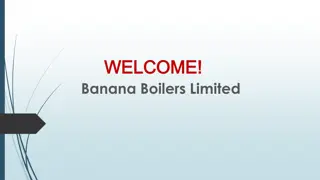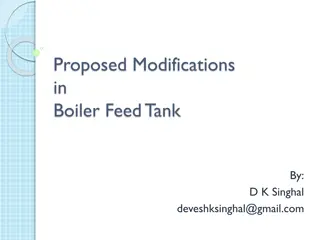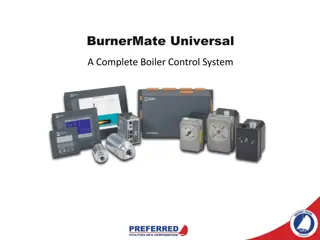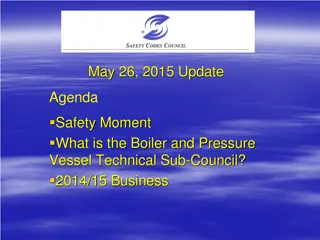Boiler Technical Panel Meeting Summary
The Boiler Technical Panel meeting discussed various topics including the Competition Act compliance, RoHS 2 obligations, Boiler Servicing Guide circulation, and PCDB listings. Actions were assigned for further follow-up on these matters. Members were reminded to adhere to the meeting policies and guidelines.
Download Presentation

Please find below an Image/Link to download the presentation.
The content on the website is provided AS IS for your information and personal use only. It may not be sold, licensed, or shared on other websites without obtaining consent from the author. Download presentation by click this link. If you encounter any issues during the download, it is possible that the publisher has removed the file from their server.
E N D
Presentation Transcript
Boiler Technical Panel Wednesday 15thNovember, Camden House, CV8 1TH
1. Welcome and Apologies Apologies received from: Martin Searle, Phil Birchenough SIME, John Thomason - Atmos
2. The Competition Act Members are reminded of the requirements of The Competition Act: As a reputable trade association, HHIC s meetings must comply with the requirements of The Competition Act. This means that we must avoid any discussion that could be construed as being anti-competitive and in particular there must be no discussion about pricing of products and services. By attending this meeting and having your names included in the minutes, all participants confirm that they agree to comply with this policy.
3. Matters arising (August 24th) RoHS 2 - MB and EH suggested, once final clarification is received, proposing to RD they draft a position, or industry communication/article, which would help educate installers on their obligations under RoHS 2. ACTION: HHIC COVERED UNDER AGENDA WEEE - It was requested that the date of 15thAugust 2018 be recorded in the minutes as a key date for WEEE 2, from when all EEE not specifically out of scope would come under the jurisdiction of WEEE 2. HHIC were also asked to circulate the relevant legislation and FAQ documents on this topic for consideration by members. ACTION: HHIC COMPLETE WEEE - There was comment that communication with the EA needed to be managed carefully, and preferably joined up with ICOM, to ensure a consistent message or line of questioning from the EUA. ACTION: HHIC COVERED UNDER AGENDA
3. Matters arising (August 24th) Boiler servicing guide - ACTION: HHIC TO CIRCULATE DOCUMENT ONCE COMPLETED COMPLETE & COVERED UNDER AGENDA BRE paper 55c flow temperature for HW storage (Heat-Pumps) SS advised he had written to Will Griffiths at BRE, flagging multiple industry documents (inc. HSE guidance) stating HW should be stored at 60c to prevent Legionella. He was awaiting a response but members felt that HHIC should push for parity here given the seemingly different requirements/assumptions being applied for SAP purposes when boilers are considered. ACTION: SS TO UPDATE CLOSED
3. Matters arising (August 24th) PCDB listings - The group discussed that although manufacturers were unlikely to be listing huge volumes of products at any one time, clearly an increase in cost was not desirable. It was discussed that steps had been taken in recent times by KIWA (as PCDB gate-keepers) to try to simplify and streamline the process, and so it would be interesting to obtain a breakdown of the increased costs. ACTION: HHIC TO FEEDBACK TO BEIS COMPLETE; HHIC MET WITH SARAH MONTGOMERY (BEIS) AND SHARED THIS REQUEST. BEIS ARE ALSO KEEN TO UNDERSTAND THE LISTING PROCESS (CARRY FORWARD TO PURSUE) Hybrids - Any members wishing to participate in the development of the SAP methodology (who are not already doing so) should make SS aware ASAP. ACTION CLOSED
3. Matters arising (August 24th) Frazer-Nash Hydrogen research - JH commented that HHIC should try and ensure if at all possible that they have sight of the Frazer-Nash work before it is presented to BEIS. ACTION: HHIC WE UNDERSTAND THE REPORT IS STILL UNDER PEER REVIEW DUE TO ONE OF THE POTENTIAL SCENARIOS IN THE REPORT
4. Boiler + / Clean Growth Strategy Clean Growth Strategy: All options for decarbonisation of heat are still on the table with more research into costs and feasibility to be done over the next 2 years, this include biogas and hydrogen Oil to be phased out of heating for new and replacement, but no immediate time table given, we expect a call for evidence soon An aspiration for all homes to be Band C by 2035 if cost effective and practical Commitment for ECO to be extended to 2035, focus on insulation Commitment for RHI but no real detail New building regulation consultation once the Grenfell enquiry is completed. SEE FIA MEETING MINUTES - UNAPPROVED https://www.gov.uk/government/uploads/system/uploads/attachment_data/file/651 232/BEIS_The_Clean_Growth_online.pdf
4. Boiler + / Clean Growth Strategy Boiler + policy - announced on Thursday 12thOctober Applicable in England only* Mandatory compliance from 6thApril 2018, with the following exceptions: - - work started on site before this date work subject to a building notice, full plans application or initial notice submitted before this date provided it is started on site before 1stOctober 210 work where a contract for installation was agreed before 6thApril 2018 and work is started on-site before 1stOctober 2018 - * plus some very specific building types in Wales
4. Boiler + / Clean Growth Strategy Boiler + key policy criteria: - Gas boilers installed or replaced in existing dwellings must be a minimum 92% ErP efficiency - Boiler interlock, time and temperature control to be present and operational (requirement applies to oil boiler replacements also) - For gas combi boilers, at least one option from the following to be specified and installed:
4. Boiler + / Clean Growth Strategy Flue Gas Heat Recovery (FGHR)* Weather compensation* Load compensation* Smart thermostat with automation and optimisation* *See links on slide 28 for technology definitions used by BEIS in Boiler + policy document and draft amendments to Domestic Building Services Compliance Guide
4. Boiler + https://www.gov.uk/government/uploads/system/uploads/attachment_data/file/ 651217/Boiler_Plus_final_policy_and_consultation_response_-_DCLG_edit.pdf https://www.gov.uk/government/uploads/system/uploads/attachment_dat a/file/651458/DBSCG_Corrigenda_ONLINE.pdf
5. HHIC/BEAMA workshop Controls definitions HHIC/BEAMA will hold a workshop to discuss the establishment of clear definitions for the control functions that are incorporated within both conventional and smart controls for heating and hot water in the residential sector. The workshop is targeted at manufacturers of such devices. Many of these definitions are already in place, but there are acknowledged inconsistencies and gaps, particularly with respect to new technologies that have emerged over the last few years. The aim is to produce a full set of generic definitions, agreed across industry, to enable performance data and policy interventions on controls to have a clear, comparable basis without impacting on the ability of manufacturers to promote or get credit for the performance of proprietary technologies. The targeted outcome of this work is an open set of definitions that UK manufacturers and policy makers will adopt, building on established definitions wherever possible. The activity is managed by HHIC and BEAMA on behalf of the BEIS Domestic Heat Strategy Group.
6. BRE paper Future of boilers in the PCDB See document
7. EHI email Energy Labelling The new Energy Labelling Regulation (EU) 2017/1369 entered into force on 1stAugust 2017. According to article 6(a), suppliers and dealers have the obligation to make reference to the energy efficiency class of the product and the range of the efficiency classes available on the label in visual advertisements or technical promotional material for a specific model in accordance with the relevant delegated act. A current absence of harmonised rules on how the range of efficiency classes has to be displayed for a specific model means dealers and suppliers have a margin of appreciation in how to comply with the obligation to display the range of efficiency classes Range should be that detailed under any existing delegated act, and will need to be updated if/when new delegated acts are adopted
8. Lot 1 & 2 Review study The Commission have launched the review of these two Regulations. Anyone with an interest is encouraged to register for updates: http://www.ecoboiler-review.eu/ http://www.ecohotwater-review.eu/ Full review of the Regulations, including 3rd party verification BEIS have suggested industry think about whether 3rd party verification is appropriate and wanted?
8. Lot 1 & 2 Review study Objectives: A quantitative evaluation of the impact of the existing regulations; An assessment regarding resource efficiency most likely disassembly, recyclability, reparability and durability following the adoption the adoption of the Circular Economy Package in December 2015 and the new Ecodesign Working Plan 2016-2019; A technology roadmap to show previous technological innovations, current product technologies including best available technologies (BAT), and concentrate mainly on an outlook of technologies yet to enter the market (BNAT) as well as general technological trends in the examined product sector, using the findings from the MEErP as a basis.
8. Lot 1 & 2 Review study EcoDesign Regulation focus: the appropriateness of setting ecodesign requirements for greenhouse gas emissions related to refrigerants, emissions of carbon monoxide, hydrocarbons and particulate matter; The appropriateness of setting stricter ecodesign requirements for energy efficiency, sound power level and emissions of nitrogen oxides; The appropriateness of setting requirements for products working on gaseous and liquid fuels from biomass; The validity of the primary energy factor (PEF); The appropriateness of 3rd party certification.
8. Lot 1 & 2 Review study Energy Labelling Regulation focus: An evaluation of the significant changes in market shares; The appropriateness of the package labels and fiches; the appropriateness of having other heating efficiency than the standardised heating season; the inclusion of passive flue heat recovery devices.
8. Lot 1 & 2 Review study Timeline:
9. LAB TQ update round-robin testing Tests will focus on the following: TC109 interest/involvement; WP1 Emissions at normal operating conditions (NOx, CO, sound power levels, etc.) WP2 Uncertainty calculations and common protocols WP3 Ecodesign testing - Hot water. Other Work Packages (no direct TC109 involvement); WP4 mCHP: WP5 GAHP: WP6 Oil Boilers: WP7 EHP: WP8 Solar See document
10. RoHS 2 & WEEE Directives HHIC have received and communicated replies from the UK authorities on queries raised by members in relation to RoHS 2 (Regulatory Delivery) and WEEE (The Environment Agency) We ask if these replies provide sufficient assurance and clarity for members, and so whether existing HHIC actions can be closed down, with the relevant communications to lie on file as evidence of industry due diligence in these matters? Review documents
Review of Defra WEEE letter Information from Defra letter Ian Smirthwaite For ease, I would like to differentiate between the 'system' (which we would deem to be the piping, pumps, radiators) and the boiler that controls it. Fossil fuel and hydronic heating systems do not meet the definition of EEE, and therefore will remain out of scope from 1 January 2019. From Defra letter Whether the boilers that power the heating systems are within scope of the WEEE Regulations will depend on if they meet the definition of EEE under regulation 2. If the electrical current is fundamental to the functioning of the boiler then it is likely to be in scope. However, if the electrical current used to support and control the primary function of the boiler (i.e. the heating of water using gas) for instance, used to ignite the gas and then close down the gas supply to control temperature, that is likely to be regarded as control and support and will be out of scope. Discussion with Ian Smirthwaite advised that Defra are not experts on all boilers designs that are on the market. Therefore if a boiler such as a microCHP unit or hybrid is available this may be in scope and would have to be reviewed as an individual case.
11. Drinking Water Directive EHI update and WRAS (P. Millard) comments See Paul Millard comments
12. Boiler PRV pipework (BS 6798) GSE-30 request to review guidance At the last GSE-30 meeting it was requested that HHIC review the guidance on boiler PRV pipework in BS 6798, and assess whether it is sufficient? Gas-Safe-Register have advised that they feel it is, and HHIC are aware that manufacturers may offer additional, bespoke guidance for this aspect of appliance installation BS 6798 (2014) guidance Clause 7.4.3: the discharge is indirectly or directly visible and will not discharge on to the occupants of the premises or on to any electrical components or wiring . COMMENTARY ON 7.4.3 - In addition to the requirements of 7.4.3.2 the pressure relief valve should be located where its discharge is unlikely to cause damage to the premises.
13. HHIC boiler servicing code of conduct / guide Previous draft received extensive comment from HHIC IST and Installer Committee groups Requested that the document should be purely consumer-facing, and has been redrafted accordingly A request to service/installation businesses exists to provide relevant positive images for the consumer service flow-chart (e.g. compliant ventilator, low reading on FGA display, or sample being taken?). Images should avoid branding. It has been suggested that once HHIC have an agreed draft that the next steps should be to re-engage with Which? in the first instance?
14. Gas Appliances Regulation update The Commission have produced an annotated draft of the previously circulated GAD-AC FAQ document. Specific areas of interest may be: Risk Assessment comments that the availability of a product standard should not be the starting point for a risk assessment, and that standards primarily serve to address and mitigate known product risks, not to identify them initially State of the art comment that agreed standards yet to be harmonised under GAR could still be used as a reference document to reflect state of the art Spares additional comments and rationale for relevant gas spares not being deemed fittings in the context of the GAR (and that they should not have been considered so under GAD). Also, comments on fittings that a manufacturer may produce in house , and how these should be interpreted in relation to the GAR
14. Gas Appliances Regulation update Standardisation request - GAR CEN and CENELEC have been asked to offer by 2017-12-21 the references of harmonised standards to be included in the first list to be published in the OJEU under the new GAR EC notified CCMC on 2016-10-21 of the working draft Standardization Request. In accordance with the CEN-CLC rules CCMC established an ad-hoc group (SRAHG GAR ) to coordinate input from BT members and other relevant parties and to provide timely feedback, during the drafting and approval of this standardization request EC hopes to proceed very soon with the draft standardization request (next step would be its circulation for vote by the EC Committee on Standards). EC mentioned that the text of the standardization request has not been modified from a substance point of view, compared to draft received end of last year. EC is waiting for the green light from the legal services to proceed, hopefully in the coming weeks.
14. Gas Appliances Regulation update Communication of gas supply conditions: By 21 October 2017, Member States shall communicate to the EC the types of gas and corresponding supply pressures of gaseous fuels used on their territory. It is to be noted that the draft Standardization Request requests CEN to revise EN 437 Test gases - Test pressures - Appliance categories (developed by CEN/TC 238 Test gases, test pressures, appliance categories and gas appliance types ) taking the above-mentioned declared types of gas and the corresponding supply pressures into consideration. CEN/TC 238 is invited to take this information into consideration.
14. Gas Appliances Regulation update Guidance sheets: In order to ensure a coherent application of the GAD among the Member States, Guidance Sheets were developed by GADAC (Gas Appliances Directive Advisory Committee), agreed by the EC Working Group on Gas Appliances and made available on the EC website. In the context of implementation of the new GAR (2016/426/EU), GADAC had a look at the guidance sheets and identified the sheets which are still relevant under the new GAR and those which need an update. GADAC established several task groups who had been given the task to check and investigate existing Guidance Sheets. The plan is to have some guidance sheets ready for circulation to GAD WG members in the coming months.
15. UK gas pressure update on IGEM WG discussions Several IGEM meetings on this topic have taken place since summer 2017 HHIC understand that IGEM will be drafting a position paper, and possibly prioritising an additional workshop session to investigate common test methodology to establish meter working pressure (i.e. standardised test procedure for ESP operatives and downstream gas engineers) TBC HHIC/ICOM have attended all meetings and a summary of some key points, and views voiced on behalf of our members following feedback are:
15. UK gas pressure update on IGEM WG discussions 20mb working pressure at the appliance inlet (i.e. 21mb at meter outlet) is the established norm for appliance manufacturers and downstream operatives. We do not wish to see this change. Testing at full installation load is preferred as this puts safety first and does not rely on potentially incorrect assumptions on consumer usage patterns The 17mb (appliance inlet) lower pressure threshold of EN 437 is described in the standard as an extreme variance appliance test standards (e.g. EN 15502- 2-1) also suggest this pressure may provide a safety margin on the nominal 20mb appliance inlet pressure (i.e. it should not be the norm) Lowest Operating Pressure (LOP) seemingly defined in IGEM standards as 25mb, and as the lowest pressure in normal conditions at the outlet of the ECV, is being questioned by some as to whether this value is still relevant why? Consumer choice and consumer expectations need to be protected. There has been some initial talk of limiting the maximum standard load per household? GS(M)R only requires gas to be at a pressure which ensures that appliances a consumer can reasonably be expected to operate, do so safely. Where does the UK gas pressure communication for GAD/GAR fit, and could the IGEM GQ standard be used to provide specific pressure values/ranges?
16. IGEM Gas Quality standard First draft for review (T17 0147) The principle objective of the working group is the production of an IGEM standard covering UK gas quality specification in order to facilitate a change from GS(M)R that reflects the decline in UKCS, the available alternative sources of gas and aligns with the European standard. The standard will set the Wobbe Index (WI) range appropriate for the UK initially examining the extension of the upper range. The specification will also examine the further widening in the lower range and changes to other quality parameters at an appropriate stage as and when the evidence emerges. Alongside this technical review there is a parallel process reviewing the legislative and regulatory case for change.
17.1 - BEIS Hydrogen project HHIC are delighted to announce that member KIWA Gastec are part of a successful consortium awarded a contract by BEIS to undertake further research into the use of Hydrogen to fuel domestic heating and cooking appliances. The successful consortium, under the guidance of project management team Arup, will use 25m of BEIS funding to undertake a comprehensive work package, formed of 9 specific elements. KIWA Gastec will offer key technical expertise and test/research functions: WP1 Programme management WP2 Definition of a Hydrogen quality standard WP3 Establishing an appliance and equipment testing capability WP4 Development of domestic Hydrogen appliances WP5 Understanding commercial appliances WP6 -Understanding industrial appliances WP7 Assessment of suitability of existing buildings WP8 Trialling Hydrogen appliances in unoccupied buildings WP9 Preparations for occupied consumer trial
17.1 - BEIS Hydrogen project The ambitious project is expected to culminate by 2021 in the supply of Hydrogen to approximately 300 houses, complete with a range of appliances designed, tested and certified for use with Hydrogen gas. The appliances to be produced will include as a minimum, a combi boiler, a standard gas cooker/hob, and three different designs of gas fire (standard, mid-range, executive). This is breaking news and HHIC will keep members posted of further developments. A press announcement by BEIS is expected imminently. It is clear that HHIC & ICOM will be key contributors to the project, and we look forward to facilitating further engagement between the project team and, in particular, appliance manufacturers.
17.1 BEIS Hydrogen project BEIS project (continued .HHIC meeting notes): By 2020/2021, small estate, village etc. of approximately 300 homes to be converted to H2 .or bespoke network constructed? Geographically, likely to be in area close to existing H2 infrastructure, e.g. Merseyside, Teeside, central belt Scotland .local authority competition? WP4 manufacturer engagement by Dec/Jan (HHIC) Draft Hydrogen quality standard by February (to provide certainty for manufacturers) Odorant/colourant BEIS requirement (possibly Sulphur-based still, HSE preference) Existing pressure tiers for NG to be used (e.g. 20mb to appliances) Metering issues? (approx 9.5m3/h for H2 combi compared to 3m3/h NG?) Customer declines = all-electric option? Question group reviewing IGEM standards only, product/material tend to be BS, what compatibility/performance issues need to be considered here?
17.2 - HyDeploy HyDeploy HHIC facilitated a meeting in summer 2017 for manufacturing members at KIWA Gastec (technical consultants to project). Some key topics of discussion, with lab testing set to begin in August: - Discussed G24 test gas to be used (lab testing) due to 20% H2 content and Wobbe Index of 52.09 MJ/m3 Possible variations in CO2 levels? higher temperatures? (components & seals) ODS operation? - - - - HHIC understand that lab-testing has been progressing well and that shortly testing will move to installed appliances at the Keele site through use of the bottle waggon
17.3 - Hydrogen IGEM WG update Condition of NIA funding is that the IGEM standards are reviewed for impact by Hydrogen blends and pure Hydrogen Question group reviewing IGEM standards only, product/material tend to be BS, what compatibility/performance issues, or further research, need to be considered here?
17.4 Siloxanes; DNV GL impact study (appliances) Management of siloxane levels is would currently be legislated for under the broad, generic requirements of GS(M)R; Schedule 3:
17.4 Siloxanes; DNV GL impact study (appliances) Project now concluded. HHIC are waiting on receipt of the full report, circulation of which we understand to have been authorised (NIA funded work). The project submission document talks of a post-study stake-holder event, to disseminate and gain acceptance of the findings. HHIC have an action to pursue this from the boiler manufacturers group. We understand that the GDN s involved are currently considering whether or not they will adopt the project recommendations Network Entry Agreements (NEA s) are contracts, and not in the public domain, however there are anecdotal tales that levels of 0.5mg Si m/3 are permitted in some cases. The DNV GL recommendation is to limit NEA levels to 0.23mg Si/m3 Such low-levels may be at the limits of detectability, at least for the majority of commercially available real-time detection equipment. How to enforce/monitor?
18.1 TC109 -Cen Consultants Comments review Completed actions regarding the CEN consultant s comments on EN15502-1 during meeting on the 7thNovember and morning of the 8thNovember. Further work to be carried out by sub group in January 2018.This is to enable the standard to eventually be harmonised. Instructions for installation and use of appliance The wording for technical documentation will replace design documents. Replace installation and user instructions with instructions for installation and instructions for use. N1035 Move all requirements about marking (Clause 12.2.1.4) detailed in EN15502-2 to EN15502-1 with an exception for type B boilers. This to be actioned once all the ZE comments from the CEN consultant have been completed. N1048 action to advise that the declared emissions should be completed using reference gases. Added to action list
TC109 - Hybrid Boiler Lead Appliance Hybrids two new documents have been issued. EN14825 is for electric heat pump already but is limited with a max flow temp of 65c which is not suitable for older market houses. New performance standard proposal - Max flow temp 80c, 4 test points instead of 7 as used in EN14825. (Reduced cost) TC113/299 to be requested to comment in case of overlap between TC S. Proposed addition to ERP regulation to include these medium plant products. Limit heat pump output to 30/40% boiler? Safety to be covered in EN15502-X. DHW would be calculated using EN13203-2. To be discussed at Plenary to see if 5 member states will support this as a work item. The request for wg1 is for the definition table to be expanded to clearly differentiate between hybrids covered by TC109 and the different TC S.
TC109 Intelligent Combustion Control Agreed document has now been created between the two TC S. TC58/109 It is a more general approach there are time related measurements (Wobbe) this is what the appliance has to adapt to. During auto calibration how to deal with short CO peaks. Cannot be avoided as these are part of the calibration process. During standstill huge differences in Wobbe have to be dealt with (summer stop holidays.) Manufacturers will have to work with the test house on how to apply the standard to the various technologies. ECOTEST Project - Commission wants round robin testing to include CO. Member states have CO requirements when servicing and nothing to do with an appliance performance is the view of Mr Van Rij (Committee chair) you can register for updates on the EC web site. www.ecoboiler-review.eu the study is carried out by VHK. First meeting will be around Jan 2018. www.ecohotwater- review.eu TC109 will write to VHK and Veerle at the commission to advise that CO is an item for installation and maintenance. (Dec)
TC109 Eco-design Coordination Group Next meeting is before the end of the year. Wilfred Linke gave an overview of the EC data base. Simon Froggatt gave an overview of the TC10 material efficiency standards. Should remember these are guidance documents and will cover several different product groups so they will need to be more general. Presentation received on Eco-test project
TC109 - H Gas Harmonisation SFG-GQS gas quality working group Meeting end of October 2017 Assessment until June 2018 6 Scenarios to be assessed in November 17(present situation is the basis scenario from economical assessment). Information of Wobbe variations around Europe see ENTSOG presentation to be distributed to WG1
TC109 -Gas Appliance Regulation For info Review of meeting at CCMC Review of web site http://ec.europa.eu/growth/sectors/press ure-gas/gas-appliances/directive_en
Working Group 4 Working Group 4 EN-13203 ECO test may have an influence on EN 13203 standards. Standards 2.5.6 are the priority Part 3 may be deleted boiler + solar? Part 4 mchp Part 5 complete - Hybrid Part 6 Will be submitted for formal vote gas (heat pumps) Part 7 draft proposed. passive flue heat recovery Part 8 smart control possible new group
18 Standards update 18.2 - BS 7593 Kick-off meeting for revision of standard to be held on 21stNovember. Please could members highlight to HHIC ASAP any essential changes they feel are necessary, so that these can be fed into the process? 18.3 IGEM UP/17 Two committee meetings held since last 11TP Additional images to be included to aid understanding/identification CFS-FA references to be changed to CFS-P Greater detail on renovation of conventional shared flues to be included Review of specific fire safety requirements to be outsourced
19. Each Home Counts HHIC are delighted to announce that following a constructive meeting with members of the implementation board and BEIS officials, the gas and oil heating industry will not be burdened by the additional requirements of the proposed quality mark. This has subsequently been confirmed in writing by the Chair of the Implementation Board, Dr Howard Porter. The certification of products is outside the scope of Each Home Counts. Participation in the quality mark is voluntary for any business or installer. No increased costs for the relevant manufacturers. Gas and oil boilers being installed will not be subject to the quality mark and neither will installers. https://www.eua.org.uk/hhic-secures-exemption-from-additional-red-tape-risk/
